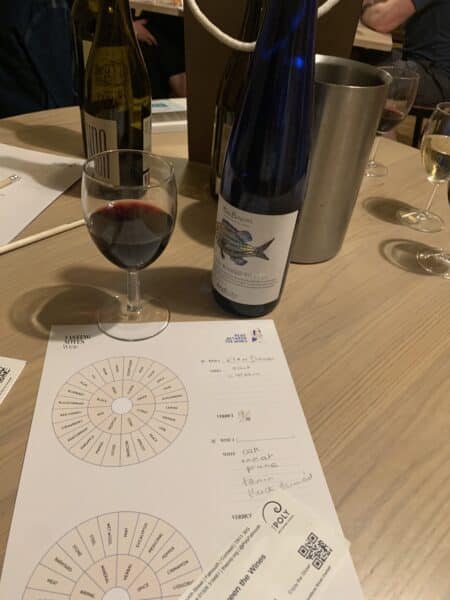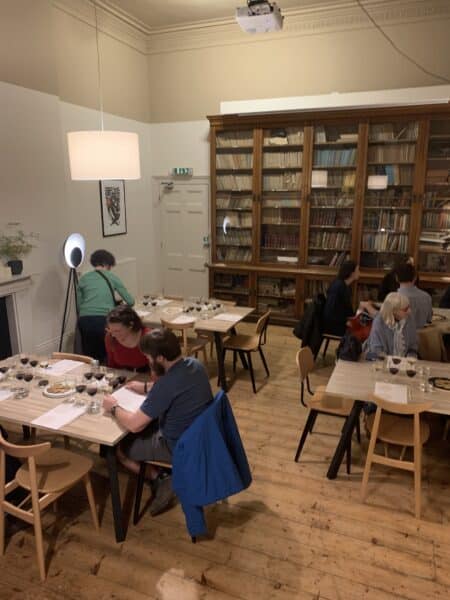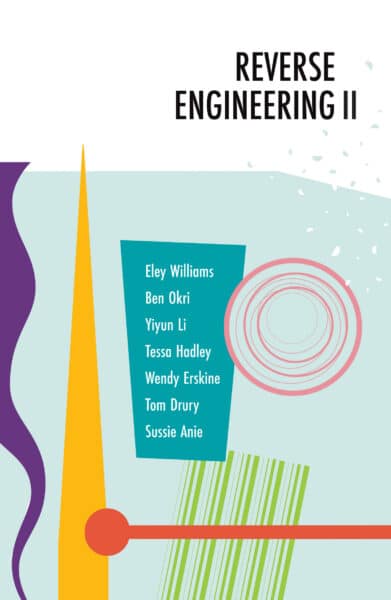A good story and a good drink. What could be better? Not much, if our audience (and enthusiastic hosts) are being asked. We had a fabulous night at the second Read Between the Wines a few weeks ago but know we left everyone hungry for more.
So, as requested here’s some of the insights from author Sussie Anie and publisher Tom Conaghan on the story we read that night, along with more detail on the wines we tasted.
If you’re interested in coming to the next Read Between the Wines sign up to our newsletter to be the first to hear about where and when it will be. Until next time!
The wines we paired with 'Maintenance'
 Wine lover and lifetime learner Lucy Howdle is working through her Wine and Spirits Educational Trust wine qualifications and has a healthy thirst for winecraft and creativity. She picked three wines to pair with Sussie Anie’s ‘Maintenance’, the short story we were primed to discuss. Here they are in all their glory, with a few notes on why she chose them…
Wine lover and lifetime learner Lucy Howdle is working through her Wine and Spirits Educational Trust wine qualifications and has a healthy thirst for winecraft and creativity. She picked three wines to pair with Sussie Anie’s ‘Maintenance’, the short story we were primed to discuss. Here they are in all their glory, with a few notes on why she chose them…
Wine 1: Faustino Rivero Ulecia Albarino, 12.5% ABV
Grape: 100% Albarino
Consisting of the majority of grapes grown in the Northwest Rias Baixas region of Spain, Albariño is quickly gaining esteem for its playfulness and whimsical nature. It’s a delightfully refreshing coastal white that grows on the Iberian Peninsula – Galicia in Northwestern Spain, loved for its rich stone fruit flavours, a hint of salinity, and zippy acidity.
Aromas:
- Citric hints on the nose, like lime / lemon
- Floral notes with an elegant herbal background
- Peach
- Grapefruit
- Honey
Taste:
Mouth-watering and clean, this wine has a complexity that is nearly impossible to dislike. A cleansing minerality on the finish leaves the palate ready for more.
- Apples, lime, peaches, flowers and grass
- Citrus
- Salinity / sea salt (because it comes from a coastal area)
- Lemon pith
- Wet stone
- Peach
Why did Lucy choose it?
“We started our evening’s wine pairings with quite a literal one – Albarino is light, citrus, clean, fresh. The lemony notes took us straight to Dr Clean Up in the Loop, working his way through the corridors with his mop and trolley.
But also, I chose this wine for its unequivocal sense of place. Its salinity, informed by its location, its flavour a result of its climate. The story too, has such an undeniable sense of place it felt like a powerful fit.”
Wine 2: Malsenda Crianza Ribera del Duero, 14.5% ABV
Grape: 100% Tempranillo
Another Spanish wine, this time from Ribera del Duero – central Spain, these wines are known for being strong and rich in colour, filled with dark fruit, tobacco and vanilla flavours. Tempranillo is a thick-skinned, deeply-coloured grape variety that gives juicy strawberry, spice and leather notes to the great red wines of Rioja and Ribera del Douro.
Aromas:
Candied fruits, are perfectly integrated with the sweet spices that gives this wine an elegant character.
- Ripe fruits
- Vanilla (from oak)
- Spices
- Tobacco / Leather – typically from aging
- Forest fruit – plum, blackcurrant
- Chocolate
Taste:
- Tannic
- Ripe fruits
- Tobacco / Leather
Why did Lucy choose it?
“This one is a bit of an insider cheat, not something our audience could have guessed. The wine is grown in sandy, loamy soils which lends itself to pairing because of the pervasive nature of sand in the story.
Made of large particles, sandy soils are known to offer good drainage and to retain heat which gives the wine a lot of its character.”
“ The experience of this wine is very similar to the story itself. It has a long lingering finish – the sign of a quality wine – but also links back to the end of Maintenance that stays with you. ”
Lucy Howdle, Read Between the Wines' wine host

Wine 3: Chateau Perron Lalande de Pomerol, 14.5% ABV
Grape: Merlot & Cabernet Sauvignon & Cabernet Franc
A blend of 80% Merlot, 10% Cabernet Sauvignon, 10% Cabernet Franc with around 18 months in oak (25% new), this is a Bordeaux from the Right Bank with a rounded Merlot fruitiness that balances out the more tannic characteristics of the Cabernet Franc. The excellent combination of location, climate, soil and historically regarded, enormous care of winemakers is what makes Lalande-de-Pomerol wine stand out.
Aromas:
A powerful and complex bouquet offering up an array of aromas from red-berried fruit, damp earth and a touch of mocha to toasty notes – the fruit of excellent wine craftsmanship. It reveals fresh blackberry, iris, peony and small blue fruits associated with varietal touches as well as hints of red fruits and discreet traces of liquorice.
- Red fruits
- Dark spice
- Fresh oak
- Cocoa
Taste:
A charming, easy to drink wine that will go well with any food. It has a supple, velvety palate with fine, crisply elegant tannins.
- Red fruit, plum
- Coconut
- Earthy-spicy notes like leather
- Fleshy blackberry, strawberry
- Blue fruits associated with touches of flowers (peony, iris)
- Hints of liquorice, caramelisation and very fine hints of vanilla
Why did Lucy choose it?
“Many layered and complex – I thought the experience of this wine was very similar to the story itself. It has a long lingering finish – the sign of a quality wine – but also links back to the ending of ‘Maintenance’ and how it stays with you, by being quite unexpected.
Its notes of cocoa made me think of the beautiful quote from the story that, “given enough time, all stories mature to truth. The truest story is of theft and decay; of returning all to dust. At the start there was only dust. From dust came gold, bauxite, sugar, cocoa and more…”
Also, for a bonus point, I found out that China has become the biggest importer of Bordeaux wines and 160 Bordeaux Chateau are now under Chinese ownership – a literal connection to the Chinese-owned biotech facility in the story.”
“ Given enough time, all stories mature to truth. The truest story is of theft and decay; of returning all to dust. At the start there was only dust. From dust came gold, bauxite, sugar, cocoa and more… ”
Sussie Anie, 'Maintenance'
Author Sussie Anie on the flavour notes of 'Maintenance' and the role of the senses in storytelling
The world Dr. Clean-up lives is so vivid and realised, even in the finest detail. Did flavour or scent play any part in that world-building for you as you were writing and editing and if so, how did you use them?
Yes – flavour and scent were really important for making that world sharp and immersive – I like to map out the sensory experience for characters in all that I write, in part because it helps me to find my way into and through the story, and also because it feels truthful. Senses really shape the experience of the world, and through this, shape the way characters interact and the choices they make. I wanted the reader to experience that too, so I included (and layered) details to envelope them in that world. In fiction it’s easy to focus on visuals, but taste and fragrance are far more evocative. They can almost work like spells in how inescapable and haunting they might be. Taste and fragrance are closely related – they are both inhaled, and leave a very physical impression in the body, which also worked with the themes of imperialism/borders/the body and technology.
Some of your descriptions lean into flavour, but in an unexpected way. Are they hard fought to find and worked through over and over, or do they come quickly and instinctively?
In this case they came quickly and instinctively. That was what made writing this story such a joy – the contrasting themes and possibilities studded across the terrain of this world gave rise to so many ideas, it was as though I was chasing them, following Dr Clean-up through the story, and trying to keep up with his imagination and observations. It was through editing that I pared down on some descriptions to keep the story moving, and keep the world from being too fleshed out, to leave space for uncertainty and for readers’ imaginations to fill. Writing a story that was about storytelling also opened more space for inspiration, and for me to have fun with language and metaphor.
How do the senses influence you when you’re writing? Do you have foods/drinks/scents that you can’t write without, or that you can guarantee will help you get through a stuck patch?
I am a big fan of black coffee at the start of each day. Also I love fruit tea/infusions while I’m writing. I enjoy scented candles too, especially through the winter months. Sound is more important when I want to get into flow – I always write to music (with breaks for dancing).
"The possibilities studded across the terrain of this world gave rise to so many ideas, it was as though I was chasing them, following Dr Clean-up through the story, and trying to keep up with his imagination..."
Why do you think flavour, scent, food and drink are important in writing in general?
I think flavour and scent in particular are important because they help ground us in the world, they come with each breath we take, and when in danger, our senses are heightened – especially our sense of smell. Stories are often ‘heightened experiences’, examining significant moments or observations, so really drawing on the senses can enhance writing (and the writing process too). Food and drink can also prevent stories from becoming too cerebral – opening space for the whole body to participate in the fiction experience. This allows for fuller explorations of the worlds fiction opens.
If ‘Maintenance’ brought one scent, flavour, food or drink to mind for you, what would it be and why?
Lemon – a chemical detergent smell. Also because lemon is quite bright/sunny in my mind, which goes with the setting.
Publisher Tom Conaghan (Sussie Anie's story is featured in Reverse Engineering II) on 'Maintenance' and its power
Why did you choose ‘Maintenance’ to feature in the Reverse Engineering collection?

‘Maintenance’ grabbed me from the first time I read it. The story takes a superb and innovative energy from the charge created between the two worlds. Sussie is masterful at placing them at just the perfect proximity/distance. Without Kwesi’s home, the story of the Loop might feel remote science fiction. Without the Loop, Kwesi’s stories would just be tall tales. The ending I find unexpectedly terrifying. Because it is not written with any of the usual conventions of horror it’s all the more powerful, the way it ‘grabs us from behind’.
In the ending, and in the story as a whole, it feels like nothing else. By bringing in deep resonating themes but never stating any explicitly, its power is huge but its mechanics sit just out of view – the story feels like old magic.
Did you get a sense of how flavour and taste are used within the story to world build? If so how and where?
When I read a brilliant story, the reaction is more than merely mental and emotional, I have a strong sense of its texture. Sussie’s story creates two worlds that seem different because they are palpably opposed. Kwesi’s homelife feels hot and windy, things grow inadvertently, things are naturally mixed necessitating hard textures and a high tolerance to the dust and bits of the “sand-scoured plains” that get on everything. It feels un-shored up against threats, and because Kwesi’s family are vulnerable to the elements they have to live partially in harmony with the chaos.
The Loop is quite an amazing and unprecedented opposing pole. Like an alien spaceship, it sits on the same land but it is not of the land. It’s sleek, metal, sterile. Everything here is artificial. Without roots in the earth, the things that are grown here also have no precedent. As opposed to the conservative and preserving chaos of nature, this setting is governed by the revolutionary chaos of experimentation. In the opening, we learn Professor Li has had to fly home because his ankles have swelled red, and we gain the sense that the story will trace the developing mutual hostility between the two environments.
"The Loop is scrupulously clean and cold. Its edges are crisp and surfaces smooth, although in its depths are the strange and wondrous and novel..."
What scents/flavours come to mind when you read or think about the story?
Each of the two worlds have a very distinct flavour. The Loop is scrupulously clean and cold. Its edges are crisp and surfaces smooth, “the glass sheets and black tarmac” – although in its depths are the strange and wondrous and novel. It is the paradigm of the New World, impatient with tradition, intrigued by biotechnology to improve on nature, like the people “studded with computers small as cashews.”
By contrast, Kwesi’s Ghana is silty, rudimentary and genuine. His way of life is the fruit of experience and long tradition passed on through the intimacy of storytelling – how the community defines itself and understands its threats. It is tough and thick to withstand the conditions: “jeans and dust-bronzed vests.”
Finally, why do you think taste and smell, flavour and fragrance are important in writing in general? What role can they play for the writer and for the reader of a work?
These are the truly sensuous senses. If sight is the ever-ready realm of the conscious and our busy mundane life, then taste and smell are the deeper darker wormholes to the unconscious – the non-cranial, instinctive, the things we didn’t know we knew. It contains memories of our youth and childhood and the animals we forgot we were.
When a writer uses taste and smell, I’m launched as if from a cannon into their world. I am strangely with Mrs Dalloway on the bus; in New Mexico with Willa Cather’s bishop; in the bowels of the Loop as its chimera emerge at me.
+
Sign up to the Read Between the Wines newsletter to be the first to hear about future events, collaborations and happenings…